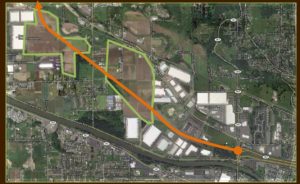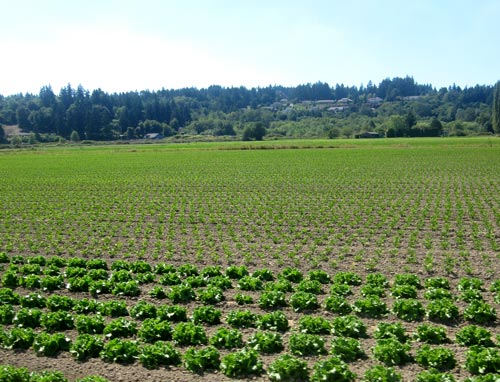Our food system–the system of growing, harvesting, distributing, and selling food–is fragile! To most, it looks in good health. Stop in any grocery store, stroll through Pike Place Market, visit your local farmers market or drive through a McDonald’s and there is plenty of food! From an eater’s perspective, there is no problem. There seems to be enough food, just that perhaps there is a distribution or cost problem because the poor can’t afford or get enough.

Puyallup Bottomlands Farmland
The food system is vital to our well-being, but goes largely unnoticed because it seems to be working. Our food system is like an onion, though as there are many layers and it is not pleasant to examine the layers as it is uncomfortable or bring tears to our eyes. Peeling back the food system layers, our eyes start to water and focus becomes blurred when realizing how complex and confusing it really is. Similar to slicing and sautéing an onion quickly, it’s much easier to avoid examining the layers of the food system.
This blog will look briefly at elements of the food system and where it is fragile. Realize that 500-page books, year-long college classes, multiple non-profit’s missions, and countless articles have all focused on the system’s frailness, so this is only touches lightly on the topic. Even so, positive changes are happening and we are getting the opportunity to eat more healthfully because more attention is being paid to what we eat and how it is grown. Despite this, there is still much work to be done to build a food system that serves all participants from farm-laborers, to farmers, to food preparers and eaters.
Where do we begin?
Mass produced food is cheap. Most eaters consume cheap food, because deals abound at Jack in the Box, McDonald’s, Wendy’s, Olive Garden, you name the fast-food chain. Two for the price of one. Buy one (calorie, fat and sugar laden food item), get one free. The mass marketed “drive-thru and go” and nationwide family-diner food providers buy their wares from huge multi-national corporations (think Kraft, ConAgra, just to name a few), that produce oodles of calories. The healthier fruits and vegetables that the Center for Disease Control (“CDC”) recommends that we eat often do not show up on the menu or are loaded with croutons, bacon bits, cheese, and dressing defeating the purpose of eating them. Granted there are food chains such as Chipotle that are breaking this traditional mold, but they have had problems scaling their healthy fast-food business model.
The CDC’s recommendations are directly in conflict with the U.S. Department of Agriculture’s (“USDA”) heavy subsidization (with our tax dollars) of commodity crops like wheat, corn, and soy through Congress’ authorization of Farm Bill every five years. The commoditized, subsidized products feed our nation’s cattle, swine, and chicken supply, producing cheap meat products. The healthy diet recommendation that half our plate be filled with fruits and vegetables gets minimal tax dollar support and are consequently significantly more expensive. Hence, the uniformed eater, which too many of us are, chows down on low quality, cheap food. It tastes good or at least tastes the same all the time! It’s portable. It’s quick. It’s inexpensive. It fills us up! The consequences: obesity, heart disease, and diabetes.
To add more fodder to a broken food system, the food growing profession doesn’t get the respect it deserves. Think of the average farm worker. An immigrant (often in this country illegally), earning a very low wage in the heat, rain, mud, and cold to plant, till, prune, and harvest food. Cheap food does not support these minimum wage workers.

Proposed State Route 167 in the Puyallup Valley
Furthermore, farmland, especially when located in proximity to thriving metropolitan areas, is threatened daily for conversion to housing developments and retail shopping malls. Developers aren’t the only threat to farmland. When a State or Federal transportation department looks for a new highway route or overpass, farmland is the cheapest ground around. We have a great example about one-half hour south of Seattle. The completion of Washington State Route 167 from Interstate 5 to downtown Puyallup will be built on some of western Washington’s best farmland–the Puyallup River bottomlands. The proposed highway location is shown on the adjacent map in orange, while some of the farm properties are outlined in bright green. Last legislative session, the Washington State elected officials brokered a deal to fund the highway construction. Funding for building this section of highway has languished in the legislative process for almost 20 years. The Washington State Department of Transportation (WSDOT) already owns much of the future highway right-of-way and leases the property to local farmers, so soon this farmland that currently grows some of the best iceberg lettuce, celery, and berries will be lost to pavement.
Environmental regulations threaten farmland, too. The Skagit River delta, one hour north of Seattle, was modified with dikes and drainage infrastructure a century ago to create one of the most prolific farming regions in the world. Now Skagit farmland is threatened not so much by housing developments, but by the desire (and legal obligation through the Endangered Species Act) to enhance and protect threatened wild salmon runs. Dikes could be removed but acres of farmland would be lost.
What to do?
These are just a few of the vulnerabilities in our food system. I purchase as much food as possible that is sustainably grown, preferably from a farmer I know. My actions help to create a more robust food system.
Kathryn Gardow, P.E., is a local food advocate, land use expert and owner of Gardow Consulting, LLC, an organization dedicated to providing multidisciplinary solutions to building sustainable communities. Kathryn has expertise in project management, planning, fundraising, and civil engineering, with an emphasis on creating communities that include food production. Kathryn is a Washington Sustainable Food and Farming Network board member and on the Urban Land Institute–Northwest District Council’s Center for Sustainable Leadership planning team. Kathryn’s blog muses on ways to create a more sustainable world and good food!

